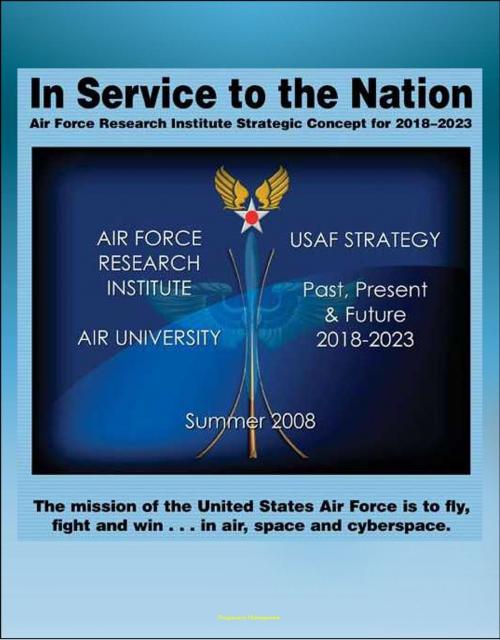In Service to the Nation: Air Force Research Institute Strategic Concept for 2018-2023 - U.S. Air Force Strategy Past, Present, and Future, Base Closures, Natural Disaster Threats to Air Force Bases
Nonfiction, History, Military, Aviation, Social & Cultural Studies, Political Science| Author: | Progressive Management | ISBN: | 9781476285993 |
| Publisher: | Progressive Management | Publication: | June 22, 2012 |
| Imprint: | Smashwords Edition | Language: | English |
| Author: | Progressive Management |
| ISBN: | 9781476285993 |
| Publisher: | Progressive Management |
| Publication: | June 22, 2012 |
| Imprint: | Smashwords Edition |
| Language: | English |
In this study, the Air Force Research Institute provides its perspective on what the United States Air Force should look like in 2018–2023. This study offers a detailed discussion of the attributes of the Air Force today in order to develop a framework for understanding how the USAF will serve the nation in the future. The USAF will remain the world’s preeminent air force, prepared to fly, fight, and win in service to the nation.
The goal of this study is to identify the enduring attributes of our nation's air, space, and cyberspace force in context of major transitions. The tasking construct identified that the study should avoid a focus on hardware and resourcing, and implied the focus should be on roles, missions, and functions "such as the transition from the Cold War to Long War—or whatever it is to be called—era." Finally, the tasking identified the study's target audience as the presidential transition teams, with a delivery date "prior to the next election."
Strategy in the post-Cold War era remains fluid. Without a focus on a single foe, it is often complicated and debatable. This study attempts to neither reinvent the USAF nor protect the status quo at the expense of conventional wisdom. The intent is to understand the value of the service's contribution to national security and, where appropriate, offer considerations for change. This study is informed by an understanding of airpower history and a realization of current USAF systems and strategies. It is not meant to be all encompassing, but rather provides insight into the most pressing issues facing the USAF in the post-Cold War era. Binding the strategy together is a redefinition of Global Vigilance, Global Reach, and Global Power; not in a weapons systems-specific context, but rather as a framework through which the USAF serves the nation.
An underlying assumption is that while major combat operations, also known as conventional campaigns, are the most dangerous to America's national interest, the conduct of irregular warfare (IW) is the most likely. Accordingly, beyond recasting Global Vigilance, Reach, and Power, the study focuses on how the USAF can contribute to winning the current fight, while simultaneously maintaining the technological superiority necessary for prevailing in the future fight.
Contents * FOREWORD * EXECUTIVE SUMMARY * 1 THE USAF TODAY * 2 FRAMING THE QUESTION * 3 THE CURRENT FIGHT * Irregular Warfare: Winning the Long War * Air Mobility * Strategic Communication: Spreading the Word * Culture and Language in the Expeditionary Air Force * Distributed Planning: The Key to Centralized Control * Unmanned Aerial Systems: The Air Force in Transition * Intelligence Reform: The Secondary Effects of Merging Intelligence with Surveillance and Reconnaissance * The Total Force in Transition * Air Base Disaster Planning: Contingency Operations * 4 RECASTING THE FUTURE (2018-23) * Definitions from CSAF White Paper (December 2007) * Proposed "Recasting" of Definitions * 5 THE FUTURE FIGHT: MAINTAINING USAF TECHNOLOGICAL SUPERIORITY * Acquisition Reform: Fixing the Process * Nuclear Surety and Deterrence: USAF at a Crossroads * Modernizing ICBMs: America's Nuclear Deterrent * Long-Range Strike: Range, Payload, Persistence—The Essence of Airpower * Space: The Ultimate High Ground * Cyberspace: Boundless Opportunity and Significant Vulnerabilities * 6 SUMMARY OF RECOMMENDATIONS * Current Fight * Future Fight
In this study, the Air Force Research Institute provides its perspective on what the United States Air Force should look like in 2018–2023. This study offers a detailed discussion of the attributes of the Air Force today in order to develop a framework for understanding how the USAF will serve the nation in the future. The USAF will remain the world’s preeminent air force, prepared to fly, fight, and win in service to the nation.
The goal of this study is to identify the enduring attributes of our nation's air, space, and cyberspace force in context of major transitions. The tasking construct identified that the study should avoid a focus on hardware and resourcing, and implied the focus should be on roles, missions, and functions "such as the transition from the Cold War to Long War—or whatever it is to be called—era." Finally, the tasking identified the study's target audience as the presidential transition teams, with a delivery date "prior to the next election."
Strategy in the post-Cold War era remains fluid. Without a focus on a single foe, it is often complicated and debatable. This study attempts to neither reinvent the USAF nor protect the status quo at the expense of conventional wisdom. The intent is to understand the value of the service's contribution to national security and, where appropriate, offer considerations for change. This study is informed by an understanding of airpower history and a realization of current USAF systems and strategies. It is not meant to be all encompassing, but rather provides insight into the most pressing issues facing the USAF in the post-Cold War era. Binding the strategy together is a redefinition of Global Vigilance, Global Reach, and Global Power; not in a weapons systems-specific context, but rather as a framework through which the USAF serves the nation.
An underlying assumption is that while major combat operations, also known as conventional campaigns, are the most dangerous to America's national interest, the conduct of irregular warfare (IW) is the most likely. Accordingly, beyond recasting Global Vigilance, Reach, and Power, the study focuses on how the USAF can contribute to winning the current fight, while simultaneously maintaining the technological superiority necessary for prevailing in the future fight.
Contents * FOREWORD * EXECUTIVE SUMMARY * 1 THE USAF TODAY * 2 FRAMING THE QUESTION * 3 THE CURRENT FIGHT * Irregular Warfare: Winning the Long War * Air Mobility * Strategic Communication: Spreading the Word * Culture and Language in the Expeditionary Air Force * Distributed Planning: The Key to Centralized Control * Unmanned Aerial Systems: The Air Force in Transition * Intelligence Reform: The Secondary Effects of Merging Intelligence with Surveillance and Reconnaissance * The Total Force in Transition * Air Base Disaster Planning: Contingency Operations * 4 RECASTING THE FUTURE (2018-23) * Definitions from CSAF White Paper (December 2007) * Proposed "Recasting" of Definitions * 5 THE FUTURE FIGHT: MAINTAINING USAF TECHNOLOGICAL SUPERIORITY * Acquisition Reform: Fixing the Process * Nuclear Surety and Deterrence: USAF at a Crossroads * Modernizing ICBMs: America's Nuclear Deterrent * Long-Range Strike: Range, Payload, Persistence—The Essence of Airpower * Space: The Ultimate High Ground * Cyberspace: Boundless Opportunity and Significant Vulnerabilities * 6 SUMMARY OF RECOMMENDATIONS * Current Fight * Future Fight















